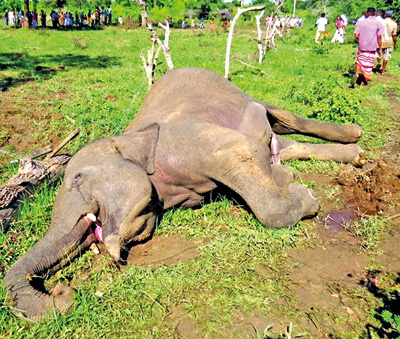News
Howls of protests but DWC allays fears
As strong protests came from environmentalists over reported moves to give out arms to personnel from the Civil Defence Force to curb the human-elephant conflict (HEC), wildlife conservation officials were quick to allay fears and concerns over trigger-happy killings of wild animals.

A tragic victim of the human-elephant conflict (HEC).
“These personnel from the Civil Defence Force would be supporting officials of the Department of Wildlife Conservation (DWC) to man the electric fences,” DWC sources said when contacted by the Sunday Times.
They will not be in the Protected Areas (PAs) but be deployed along the 4,000-odd kilometres of electric fences “eva nadaththu karanna” (to maintain them) and patrol these fences at night too, the sources stressed, pointing out that this was due to the DWC facing a dearth of effective cadres.
“They will be acting as a psychological barrier. They are well-trained in the use of firearms and will not just shoot to kill wild elephants randomly. They will shout to scare away the animals or in an extremely difficult situation fire into the air to chase the elephants away,” the sources said.
The DWC, the Sunday Times learns, is also conducting extensive awareness programmes among villagers to change their behaviour and thus reduce the HEC.
While many conservationists were critical over the reported decision to deploy armed personnel along electric fences, the Wildlife & Nature Protection Society (WNPS) also expressed serious concerns over the programme to distribute guns to members of the Civil Defence Force who would be expected to deal with crop-raiding elephants in farmlands and is seen as a part-solution to the HEC.
Several conservationists pointed out that if rifles are distributed and they are used to open fire on wild elephants, such action would kill these elephants on the spot.
The WNPS, meanwhile, cautioned that this action would exacerbate rather than mitigate the HEC in these areas, where these cadres are being given additional firearms. “We would like to know why these cadres, who are in effect a para-military force, require firearms and ammunition in addition to the service weapon routinely issued to them. Surely extra ‘duties’ don’t mean extra guns are required.”
Explaining in detail the disastrous consequences on wild elephants, the WNPS states that they would like to draw attention to the fact that even spherical lead pellets of .32 calibre shot guns (nine in each cartridge) when fired at an elephant at close range can penetrate the animal’s skin, fat and muscle layers and reach vital organs. In such cases, with a well-placed shot, the outcome would be the death of the elephant.
The WNPS going into meticulous detail states: “At a distance of 50 metres, these pellets will retain enough velocity and energy to penetrate the thick skin layers of an elephant and lodge against bone or enter muscle tissue. In most instances the wounds sustained by these gunshots will result in the eventual death of the elephant. The resultant death will be lingering and painful, with suppurating (festering) wounds or abscesses, infections and debilitating illness.
“These elephants in their pain and anger will become extremely dangerous to the humans they encounter until they eventually weaken and succumb to the complications caused by gunshot wounds.
“We would like the Minister and all the officials in the ministry and the DWC to ask themselves as to what they are hoping to achieve? Let’s be under no illusion as to what this new attempt to mitigate the HEC actually means to elephants and farming families countrywide.
“The second concern of the WNPS is that these guns will invariably be used to kill other animal species for consumption as well as the illegal trade in the meat of wild animals. This will inevitably pose a threat to the long-term survival of wildlife in those farming areas which will include species under the threat of extinction.
“As the premier conservation body in the country, with 125 years of work towards conserving Sri Lanka’s natural heritage as well as being the architect of both the Wildlife and Forest Departments, we feel it is our mandate and duty to point out the unacceptable, adverse impacts of this action to mitigate the HEC.”
Reiterating the need for the Elephant Conservation Policy to be the guideline for the mitigation of the HEC, the WNPS adds that they have stated these facts in the best interests of both the public and elephants with responsibility, after consulting experts and professionals here and abroad. “We urge that this hasty, ill-advised programme be reconsidered and reversed.”


